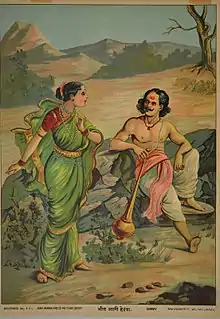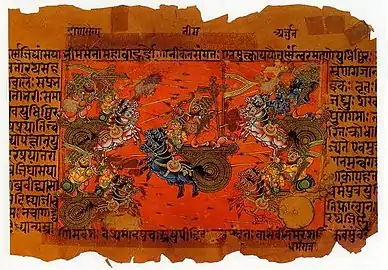Hidimbi
Hiḍimbī (Sanskrit:हिडिम्बी, IAST: Hiḍimbī), or Hiḍimbā, is the wife of the Pandava Bhima and mother of great warrior Veer Ghatotkacha in the Mahābhārata. She meets Bhima in the 9th sub-parva (Hidimva-vadha Parva) of the Adi Parva. She is also referred to as Bhuṭanadevī (भुटनदेवी) or Pallavī (पल्लवी).
| Hiḍimba | |
|---|---|
 Bheema and Hidimbi, painting by Raja Ravi Varma. | |
| Affiliation | Rakshasa, Devi |
| Abode | Kamyaka Forest |
| Texts | Mahabharata |
| Personal information | |
| Siblings | Hidimbi |
| Consort | Bhima |
| Children | Ghatotkacha |
Hiḍimbā and Bhīma
The story begins in the Lākṣāgṛha of the Mahābhārata after the Pāṇḍavās reached a dense forest. Exhausted from their travels, they all fell asleep at night, except for Bhīma who kept watch.
In the same forest lived Hiḍimbī and her brother Hiḍimbā, a very powerful rakshasa. He smelled the Pāṇḍavās at a distance and as usual asked the goddess Hiḍimbī to lure the well-built Bhīma into a trap so he could eat him. Hiḍimbī confronted Bhīma and instead fell in love with him. She assumed the form of a very beautiful lady and approached Bhīma, expressing her desire to marry him by revealing her true identity, as well as her brother's intentions. Bhīma confronted Hiḍimbā but was soon overpowered. It was only with the supernatural powers of Hiḍimbī, supporting Bhīma from a distance, that he could overcome and slay Hiḍimbā. Kuntī and other Pāṇḍavās all watched the duel from a distance.[1]

Marriage
After killing Hiḍimba, Bhīma married Hiḍimbī. Bhīma decided to live with her till a child was born. Hiḍimbī agreed and they married. Within a year, Hiḍimbī gave birth to a son. They named him Ghaṭotkaca as his head resembled a pot. Ghaṭotkaca went on to become a great warrior and an important figure in the Mahābhārata war.[2]
Temple
There is a temple in Manali in Himachal Pradesh dedicated to the worship of Hidimbi. According to the legend, Hidimbi stayed back in the forest to perform penance and attain the status of a Goddess.[3]
References
- http://ritsin.com/bhima-hidimba-mahabharata.html/
- https://zeenews.india.com/entertainment/and-more/mahabharata-s-bhima-was-married-to-a-rakshasi-do-you-know-who-she-is_1882366.html
- https://www.timesnownews.com/spiritual/religion/article/all-you-need-to-about-hidimbi-the-demoness-wife-of-bhima/520224


